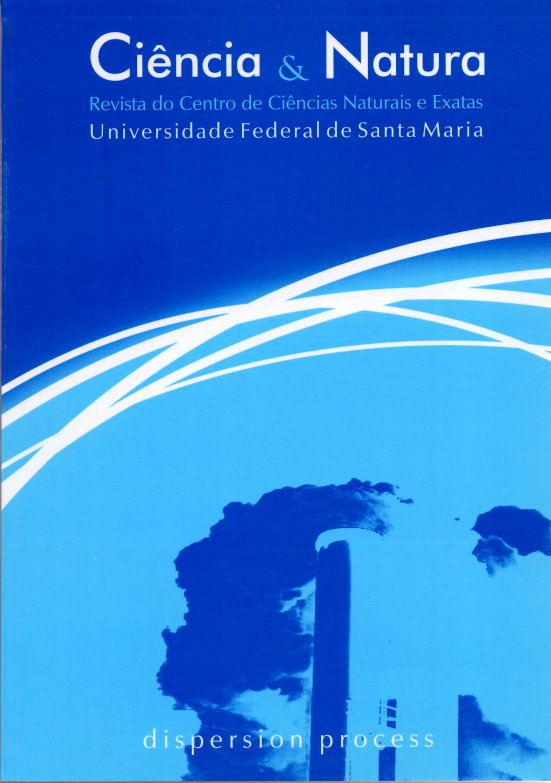Comparação entre coeficientes de difusão derivados do espectro de energia turbulenta e coeficientes de difusão que dependem da razão entre os fluxos de entranhamento e os de superfície
DOI:
https://doi.org/10.5902/2179460X63508Abstract
A most of contaminants turbulent dispersion in Planetary Boundary Layer (CLP) research is related with the concentration turbulent fluxes specification. An approach for these unknown terms allow to solve the diffusion-advection equation. The specification process of concentration turbulent fluxes parameterization is called as closure problem of turbulent transport. The simplest mathematics scheme which lead to a diffusion advection equation solution employ eddy diffusivities that relates the concentration turbulent fluxes to mean concentration gradient. In this work, employing a Eulerian dispersion model and concentration data, eddy diffusivities, derived of turbulent energy spectrum and that which depends of ratio between entrainment and surface fluxes, will be used in superficial concentration field simulation.
Downloads
References
ARYA, S. P.: Modeling and parameterization of near-source diffusion in weak winds. J. Appl. Meteor., v. 34, p.1112-1122, 1995
BERCOWICZ, R. R., OLESEN, H. R. AND TORP U. : The Danish Gaussian air pollution model (OML): description, test and sensitivity analysis in view of regulatory applications. Air Pollution modeling and its application. Pp. 453-480. Edited by C. De Wispeleare, F. A. Schiermeirier and N. V. Gillani. Plenum Publishing Corporation.1986
DEGRAZIA, G. A., CAMPOS VELHO H. F. AND CARVALHO, J. C.: Nonlocal Exchange Coefficients for the Convective Boundary Layer Derived From Spectral Properties, Beitr. Phys. Atmosph., 70, 57-64. 1997
HEYDARIAN, M. AND MULLINEAUX, N.: Solution of parabolic partial differential equations, Appl. Math. Modelling, 5, 448-449. 1989
HOJSTRUP J.: Velocity spectra in the unstable boundary layer. J. Atmos. Sci., 39, pp.2239-2248, 1982
HOLSTLAG, A. A. M. AND MOENG, C. H.: Eddy diffusivity and countergradient transport in the convective boundary layer, J. Atmos. Sci., 48, 1690-1698. 1991
PAULSEN, C. A.: The mathematical representation of wind and temperature profiles in aunstable atmospheric surface layer. J. appl. Met., 9, 857-861. 1975
VILHENA, M. T., RIZZA, U., DEGRAZIA, G. A., MANGIA, C., MOREIRA, D. M. AND TIRIBASSI, T.: An Analytical Air Pollution Model: Development and Evaluation, Contr. Atmos. Phys., 71, 315-320. 1998
Downloads
Published
How to Cite
Issue
Section
License
To access the DECLARATION AND TRANSFER OF COPYRIGHT AUTHOR’S DECLARATION AND COPYRIGHT LICENSE click here.
Ethical Guidelines for Journal Publication
The Ciência e Natura journal is committed to ensuring ethics in publication and quality of articles.
Conformance to standards of ethical behavior is therefore expected of all parties involved: Authors, Editors, Reviewers, and the Publisher.
In particular,
Authors: Authors should present an objective discussion of the significance of research work as well as sufficient detail and references to permit others to replicate the experiments. Fraudulent or knowingly inaccurate statements constitute unethical behavior and are unacceptable. Review Articles should also be objective, comprehensive, and accurate accounts of the state of the art. The Authors should ensure that their work is entirely original works, and if the work and/or words of others have been used, this has been appropriately acknowledged. Plagiarism in all its forms constitutes unethical publishing behavior and is unacceptable. Submitting the same manuscript to more than one journal concurrently constitutes unethical publishing behavior and is unacceptable. Authors should not submit articles describing essentially the same research to more than one journal. The corresponding Author should ensure that there is a full consensus of all Co-authors in approving the final version of the paper and its submission for publication.
Editors: Editors should evaluate manuscripts exclusively on the basis of their academic merit. An Editor must not use unpublished information in the editor's own research without the express written consent of the Author. Editors should take reasonable responsive measures when ethical complaints have been presented concerning a submitted manuscript or published paper.
Reviewers: Any manuscripts received for review must be treated as confidential documents. Privileged information or ideas obtained through peer review must be kept confidential and not used for personal advantage. Reviewers should be conducted objectively, and observations should be formulated clearly with supporting arguments, so that Authors can use them for improving the paper. Any selected Reviewer who feels unqualified to review the research reported in a manuscript or knows that its prompt review will be impossible should notify the Editor and excuse himself from the review process. Reviewers should not consider manuscripts in which they have conflicts of interest resulting from competitive, collaborative, or other relationships or connections with any of the authors, companies, or institutions connected to the papers.






